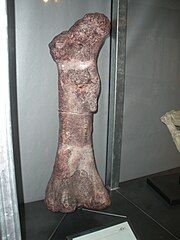Isanozaur
| Isanosaurus | |||
| Buffetaut et al., 2000 | |||
 Kość udowa isanozaura | |||
| Systematyka | |||
| Domena | |||
|---|---|---|---|
| Królestwo | |||
| Typ | |||
| Podtyp | |||
| Gromada | |||
| Podgromada | |||
| Nadrząd | |||
| Rząd | |||
| Podrząd | |||
| Infrarząd | |||
| Rodzaj |
isanozaur | ||
| Gatunki | |||
| |||
Isanozaur (Isanosaurus) – rodzaj zauropoda żyjącego na obecnych terenach Azji. Został opisany w 2000 roku przez Érica Buffetauta i współpracowników w oparciu o kość udową, kręgi i fragmenty obręczy barkowej należące do jednego osobnika. Skamieniałości te odnaleziono w osadach formacji Nam Phong w prowincji Chaiyaphum w Tajlandii. Wiek osadów, w których odkryto jego skamieniałości jest niepewny. Pierwotnie uznano, że kości Isanosaurus odkryto w osadach górnotriasowych, co czyniłoby go jednym z najstarszych jeśli nie najstarszym znanym zauropodem[1]. Późniejsze badania sugerują jednak, że skamieniałości tego zauropoda mogły w rzeczywistości zostać odkryte w osadach górnojurajskich[2].
Holotyp był stosunkowo niewielkim zwierzęciem jak na zauropoda – jego długość szacuje się na około 6,5 m – jednak prawdopodobnie zmarł przed osiągnięciem maksymalnych rozmiarów[1]. Odkryto również kości drugiego triasowego tajlandzkiego zauropoda, mierzącego prawdopodobnie 12–15 m długości[3], jednak nie ma materiału kopalnego pokrywającego się z holotypem isanozaura, dlatego też nie wiadomo, czy te skamieniałości należą do przedstawicieli jednego rodzaju. Budowa kości isanozaura wskazuje na jego przynależność do zauropodów, a nie bardziej bazalnych zauropodomorfów, jednak występuje u niego wiele cech prymitywnych dla zauropodów[4].
W roku 2000, kiedy został nazwany, Isanosaurus był najstarszym zauropodem znanym z materiału kostnego[1]. W 2003 roku opisano rodzaj Antetonitrus, pierwotnie uznany za prawdopodobnie jeszcze starszy od Isanosaurus[5]; późniejsze badania sugerują jednak, że Antetonitrus mógł żyć we wczesnej jurze, a nie w późnym triasie[6]. Nie jest też pewne, czy Antetonitrus należał do Sauropoda czy też był jedynie bliskim krewnym tej grupy[7].
Przypisy
[edytuj | edytuj kod]- ↑ a b c Éric Buffetaut, Varavudh Suteethorn, Gilles Cuny, Haiyan Tong, Jean Le Loeuff, Sasidhorn Khansubha, Sutee Jongautchariyakul. The earliest known sauropod dinosaur. „Nature”. 407, s. 72–74, 2000. DOI: 10.1038/35024060. (ang.).
- ↑ Claire Peyre de Fabrègues i Ronan Allain, Kholumolumo ellenbergerorum, gen. et sp. nov., a new early sauropodomorph from the lower Elliot Formation (Upper Triassic) of Maphutseng, Lesotho, „Journal of Vertebrate Paleontology”, 39 (6), 2020, e1732996, DOI: 10.1080/02724634.2019.1732996 (ang.).
- ↑ Éric Buffetaut, Varavudh Suteethorn, Jean Le Loeuff, Gilles Cuny, Haiyan Tong, Sasidhorn Khansubha. The first giant dinosaurs: a large sauropod from the Late Triassic of Thailand. „Comptes Rendus Palevol”. 1 (2), s. 103–109, 2002. DOI: 10.1016/S1631-0683(02)00019-2. (ang.).
- ↑ Éric Buffetaut, Varavudh Suteethorn, Jean Le Loeuff, Gilles Cuny, Haiyan Tong, Sasidhorn Khansubha: A review of the sauropod dinosaurs of Thailand. W: N. Mantajit (red.): Proceedings of the Symposium on the Geology of Thailand. Bangkok: Department of Mineral Resources, 2002, s. 95–101. (ang.).
- ↑ Adam M. Yates, James W. Kitching. The earliest known sauropod dinosaur and the first steps towards sauropod locomotion. „Proceedings of the Royal Society of London B: Biological Sciences”. 270 (1525), s. 1753–1758, 2003. DOI: 10.1098/rspb.2003.2417. (ang.).
- ↑ Claire Peyre de Fabrègues i Ronan Allain. New material and revision of Melanorosaurus thabanensis, a basal sauropodomorph from the Upper Triassic of Lesotho. „PeerJ”. 4: e1639, 2016. DOI: 10.7717/peerj.1639. (ang.).
- ↑ Blair W. McPhee, Adam M. Yates, Jonah N. Choiniere i Fernando Abdala. The complete anatomy and phylogenetic relationships of Antetonitrus ingenipes (Sauropodiformes, Dinosauria): implications for the origins of Sauropoda. „Zoological Journal of the Linnean Society”. 171 (1), s. 151–205, 2014. DOI: 10.1111/zoj.12127. (ang.).
Linki zewnętrzne
[edytuj | edytuj kod]- Luis Rey: Isanosaurus. [dostęp 2010-03-15]. [zarchiwizowane z tego adresu (19 października 2007)]. (ang.).
Text is available under the CC BY-SA 4.0 license; additional terms may apply.
Images, videos and audio are available under their respective licenses.

